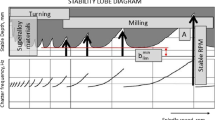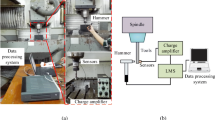Abstract
Chatter is one form of severe self-excited vibration in machining process which leads to many machining problems. In this paper, a new method of chatter identification is proposed. During the machining process, the acceleration signal of vibration is obtained and the time domain root mean square value of the acceleration is calculated every proper segment, through which the real-time acceleration root mean square (RMS) sequence is obtained. Then, the coefficient of variation (i.e., the ratio of the standard deviation to the mean, CV) of the RMS sequence is defined as the indicator for chatter identification. The milling experiment shows that CV can well distinguish the state (stable or chatter) of the machining process. The proposed method has a quantitative and dimensionless indicator, which works for different machining materials and machining parameters, and even can be expected to work in a wider range condition, such as different machine tool and cutting method. This paper also designs a fast algorithm of CV, making it an ideal candidate for online monitoring system.
Similar content being viewed by others
References
Altintas Y (2012) Manufacturing automation: metal cutting mechanics, machine tool vibrations, and CNC design, 2nd edn. Cambridge University Press, Cambridge. https://doi.org/10.1017/CBO9780511843723
Altintaş Y, Budak E (1995) Analytical prediction of stability lobes in milling. CIRP Ann Manuf Technol 44(1):357–362. https://doi.org/10.1016/S0007-8506(07)62342-7
Tlusty J, Polacek M (1963) The stability of the machine tool against self-excited vibration in machining. ASME Int Res Prod 1:465–474
Siddhpura M, Paurobally R (2012) A review of chatter vibration research in turning. Int J Mach Tools Manuf 61:27–47. https://doi.org/10.1016/j.ijmachtools.2012.05.007
Quintana G, Ciurana J (2011) Chatter in machining processes: a review. Int J Mach Tools Manuf 51(5):363–376. https://doi.org/10.1016/j.ijmachtools.2011.01.001
Zhu K, Wong YS, Hong GS (2009) Wavelet analysis of sensor signals for tool condition monitoring: a review and some new results. Int J Mach Tools Manuf 49(7–8):537–553. https://doi.org/10.1016/j.ijmachtools.2009.02.003
Altintas Y, Weck M (2004) Chatter stability of metal cutting and grinding. CIRP Ann Manuf Technol 53(2):619–642. https://doi.org/10.1016/s0007-8506(07)60032-8
Cao H, Zhang X, Chen X (2017) The concept and progress of intelligent spindles: a review. Int J Mach Tools Manuf 112(Supplement C):21–52. https://doi.org/10.1016/j.ijmachtools.2016.10.005
Liu C, Zhu L, Ni C (2017) The chatter identification in end milling based on combining EMD and WPD. Int J Adv Manuf Technol 91(9–12):3339–3348. https://doi.org/10.1007/s00170-017-0024-8
Zhang Z, Li H, Meng G, Tu X, Cheng C (2016) Chatter detection in milling process based on the energy entropy of VMD and WPD. Int J Mach Tools Manuf 108:106–112. https://doi.org/10.1016/j.ijmachtools.2016.06.002
Tangjitsitcharoen S, Saksri T, Ratanakuakangwan S (2013) Advance in chatter detection in ball end milling process by utilizing wavelet transform. J Intell Manuf 26(3):485–499. https://doi.org/10.1007/s10845-013-0805-3
Feng J, Sun Z, Jiang Z, Yang L (2015) Identification of chatter in milling of Ti-6Al-4V titanium alloy thin-walled workpieces based on cutting force signals and surface topography. Int J Adv Manuf Technol 82(9–12):1909–1920. https://doi.org/10.1007/s00170-015-7509-0
Huang P, Li J, Sun J, Ge M (2011) Milling force vibration analysis in high-speed-milling titanium alloy using variable pitch angle mill. Int J Adv Manuf Technol 58(1–4):153–160. https://doi.org/10.1007/s00170-011-3380-9
Dong X, Zhang W (2017) Chatter identification in milling of the thin-walled part based on complexity index. Int J Adv Manuf Technol 91(9–12):3327–3337. https://doi.org/10.1007/s00170-016-9912-6
Han Z, Jin H, Han D, Fu H (2016) ESPRIT- and HMM-based real-time monitoring and suppression of machining chatter in smart CNC milling system. Int J Adv Manuf Technol 89(9–12):2731–2746. https://doi.org/10.1007/s00170-016-9863-y
Fu Y, Zhang Y, Zhou H, Li D, Liu H, Qiao H, Wang X (2016) Timely online chatter detection in end milling process. Mech Syst Signal Process 75:668–688. https://doi.org/10.1016/j.ymssp.2016.01.003
Cao H, Zhou K, Chen X (2015) Chatter identification in end milling process based on EEMD and nonlinear dimensionless indicators. Int J Mach Tools Manuf 92:52–59. https://doi.org/10.1016/j.ijmachtools.2015.03.002
Lamraoui M, Thomas M, El Badaoui M (2014) Cyclostationarity approach for monitoring chatter and tool wear in high speed milling. Mech Syst Signal Process 44(1–2):177–198. https://doi.org/10.1016/j.ymssp.2013.05.001
Cao H, Zhou K, Chen X, Zhang X (2017) Early chatter detection in end milling based on multi-feature fusion and 3σ criterion. Int J Adv Manuf Technol 92(9):4387–4397. https://doi.org/10.1007/s00170-017-0476-x
Ding L, Sun Y, Xiong Z (2017) Early chatter detection based on logistic regression with time and frequency domain features. In: 2017 I.E. International Conference on Advanced Intelligent Mechatronics (AIM), 3–7 July 2017. pp 1052–1057. https://doi.org/10.1109/AIM.2017.8014158
Sallese L, Grossi N, Scippa A, Campatelli G (2017) Investigation and correction of actual microphone response for chatter detection in milling operations. Measurement and Control 50(2):45–52. https://doi.org/10.1177/0020294017702285
Cao H, Yue Y, Chen X, Zhang X (2016) Chatter detection in milling process based on synchrosqueezing transform of sound signals. Int J Adv Manuf Technol 89(9–12):2747–2755. https://doi.org/10.1007/s00170-016-9660-7
Lei N, Soshi M (2016) Vision-based system for chatter identification and process optimization in high-speed milling. Int J Adv Manuf Technol 89(9–12):2757–2769. https://doi.org/10.1007/s00170-016-9770-2
Lamraoui M, El Badaoui M, Guillet F (2015) Chatter detection in CNC milling processes based on wiener-SVM approach and using only motor current signals. In: Sinha JK (ed) Vibration engineering and technology of machinery: proceedings of VETOMAC X 2014, held at the University of Manchester, UK, September 9–11, 2014. Springer International Publishing, Cham, pp 567–578. https://doi.org/10.1007/978-3-319-09918-7_50
Kakinuma Y, Sudo Y, Aoyama T (2011) Detection of chatter vibration in end milling applying disturbance observer. CIRP Ann Manuf Technol 60(1):109–112. https://doi.org/10.1016/j.cirp.2011.03.080
Rafal R, Pawel L, Krzysztof K, Bogdan K, Jerzy W (2015) Chatter identification methods on the basis of time series measured during titanium superalloy milling. Int J Mech Sci 99:196–207. https://doi.org/10.1016/j.ijmecsci.2015.05.013
Liu Y, Wu B, Ma J, Zhang D (2016) Chatter identification of the milling process considering dynamics of the thin-walled workpiece. Int J Adv Manuf Technol 89(5–8):1765–1773. https://doi.org/10.1007/s00170-016-9190-3
Lamraoui M, Thomas M, El Badaoui M, Girardin F (2014) Indicators for monitoring chatter in milling based on instantaneous angular speeds. Mech Syst Signal Process 44(1):72–85. https://doi.org/10.1016/j.ymssp.2013.05.002
Ding SL, Izamshah RAR, Mo JPT, Zhu YW (2010) Chatter detection in high speed machining of titanium alloys. Key Eng Mater 458:289–294. https://doi.org/10.4028/www.scientific.net/KEM.458.289
Uekita M, Takaya Y (2017) Tool condition monitoring technique for deep-hole drilling of large components based on chatter identification in time–frequency domain. Measurement 103:199–207. https://doi.org/10.1016/j.measurement.2017.02.035
Ji Y, Wang X, Liu Z, Yan Z, Jiao L, Wang D, Wang J (2017) EEMD-based online milling chatter detection by fractal dimension and power spectral entropy. Int J Adv Manuf Technol 92(1–4):1185–1200. https://doi.org/10.1007/s00170-017-0183-7
Lamraoui M, Barakat M, Thomas M, Badaoui ME (2013) Chatter detection in milling machines by neural network classification and feature selection. J Vib Control 21(7):1251–1266. https://doi.org/10.1177/1077546313493919
Kuljanic E, Totis G, Sortino M (2009) Development of an intelligent multisensor chatter detection system in milling. Mech Syst Signal Process 23(5):1704–1718. https://doi.org/10.1016/j.ymssp.2009.01.003
Lu K, Lian Z, Gu F, Liu H (2018) Model-based chatter stability prediction and detection for the turning of a flexible workpiece. Mech Syst Signal Process 100(Supplement C):814–826. https://doi.org/10.1016/j.ymssp.2017.08.022
Yamato S, Hirano T, Yamada Y, Koike R, Kakinuma Y (2017) Sensor-less on-line chatter detection in turning process based on phase monitoring using power factor theory. Precis Eng. https://doi.org/10.1016/j.precisioneng.2017.07.017
Balachandran B (2001) Nonlinear dynamics of milling processes. Philosophical transactions of the Royal Society of London Series A: Mathematical. Phys Eng Sci 359(1781):793–819. https://doi.org/10.1098/rsta.2000.0755
Long XH, Balachandran B (2007) Stability analysis for milling process. Nonlinear Dyn 49(3):349–359. https://doi.org/10.1007/s11071-006-9127-8
Acknowledgements
The authors would like to acknowledge the support of China Postdoctoral Science Foundation(2017M610880) and Shenzhen Foundational Research Project (Subject Layout) (JCYJ20160428181916222).
Author information
Authors and Affiliations
Corresponding author
Rights and permissions
About this article
Cite this article
Ye, J., Feng, P., Xu, C. et al. A novel approach for chatter online monitoring using coefficient of variation in machining process. Int J Adv Manuf Technol 96, 287–297 (2018). https://doi.org/10.1007/s00170-017-1544-y
Received:
Accepted:
Published:
Issue Date:
DOI: https://doi.org/10.1007/s00170-017-1544-y




